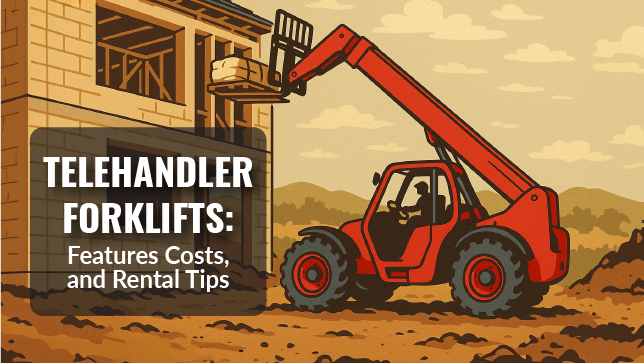Whether you’re managing a construction site, setting trusses for a building, or moving heavy materials on uneven ground, renting a telehandler can be the most practical and cost-effective solution. These versatile machines—sometimes referred to as telescopic forklifts—combine the lifting power of a forklift with the reach of a crane, making them indispensable for a wide range of projects.
But before you book your rental, it’s essential to understand what drives telehandler rental costs and how much you can expect to pay.
In this guide, we’ll break down everything you need to know about telehandler rental features, costs and pricing in 2025—from average daily, weekly, and monthly rates to the key factors that affect cost. Whether you’re renting for a short-term job or a multi-month project, we’ll help you make the most informed decision possible—and potentially save money along the way.
Let’s dive in!
What Is a Telehandler and When Do You Need One?
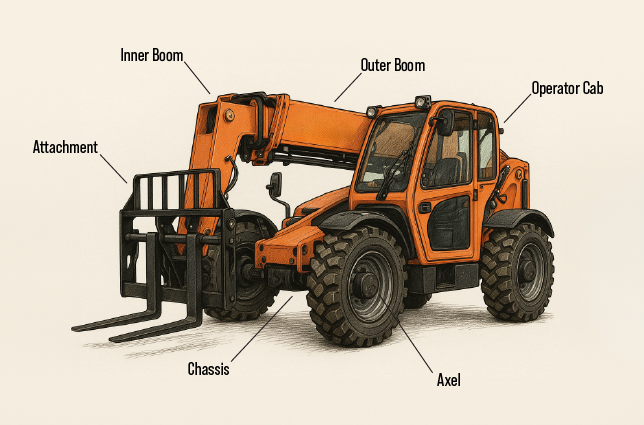
Defining a Telehandler
A telehandler is a lifting machine with a long telescoping boom arm, often described as a cross between a forklift and a small crane. It can attach to forks, buckets, and other tools to lift and place materials at various heights and distances. Telehandlers are commonly used on construction sites, farms, and warehouses for their ability to handle heavy loads on rough terrain and reach higher than standard forklifts.
Job Scenarios That Require Telehandler Rental
Rough Terrain Sites
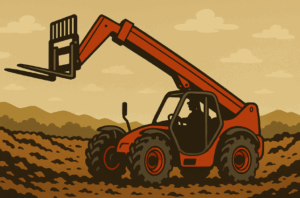
Telehandlers are built for off-road conditions. Construction sites or farms with mud, gravel, or uneven ground often require a telehandler to move loads where a standard forklift can’t operate. Heavy-duty tires and 4×4 drive let telehandlers maintain traction on rough terrain.
High-Reach Tasks
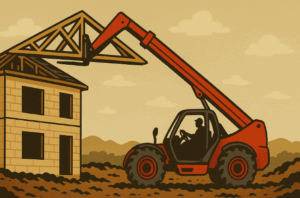
When materials need to be lifted to upper floors of a building or onto rooftops, a telehandler’s boom provides the necessary reach. These machines can lift pallets of bricks, trusses, or other materials dozens of feet in the air, far beyond the reach of a typical forklift.
Versatility with Attachments
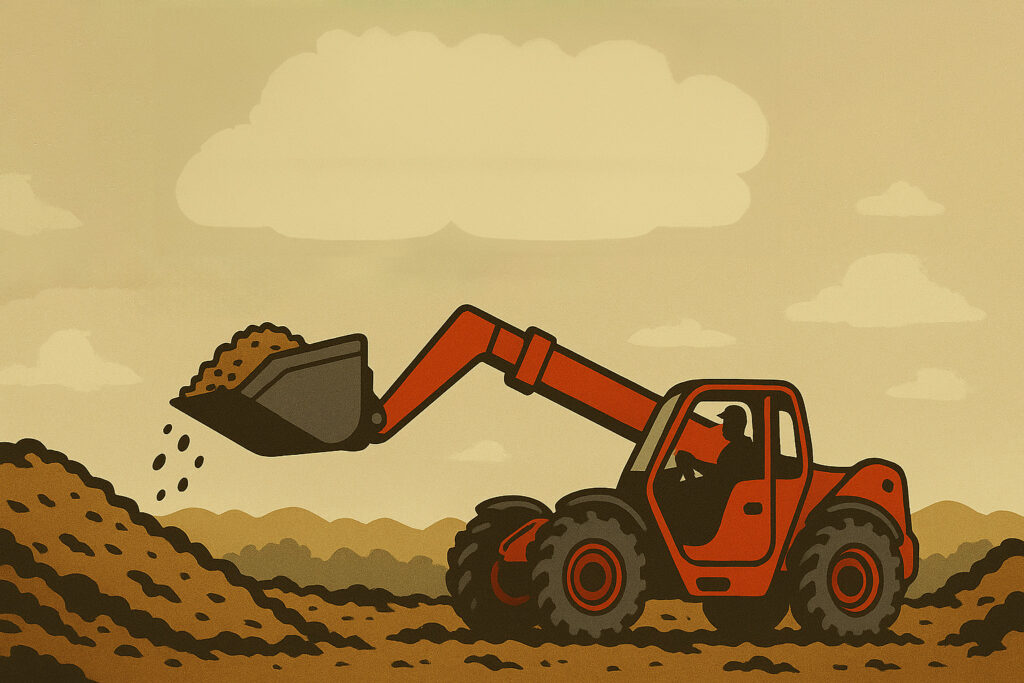
Telehandlers accept many attachments (beyond just pallet forks) such as buckets, grapple hooks, and personnel work platforms. This makes them useful for diverse jobs – for example, scooping and moving loose gravel with a bucket or lifting workers in a cage for elevated installation tasks. One telehandler can perform multiple roles by swapping attachments as needed.
Average Telehandler Rental Costs in 2025
Telehandler rental rates can vary widely based on the machine’s size and how long you need it. As a ballpark figure, our data shows telehandlers rent for around $1,756 per week on average in the U.S (Not including transportation and other fees). However, your actual cost will depend on whether you rent by the day, week, or month, and the telehandler’s specifications. (For comparison, standard forklifts generally rent for less due to their smaller size – see our guide on forklift rental costs for details.)
Cost Breakdown by Timeframe
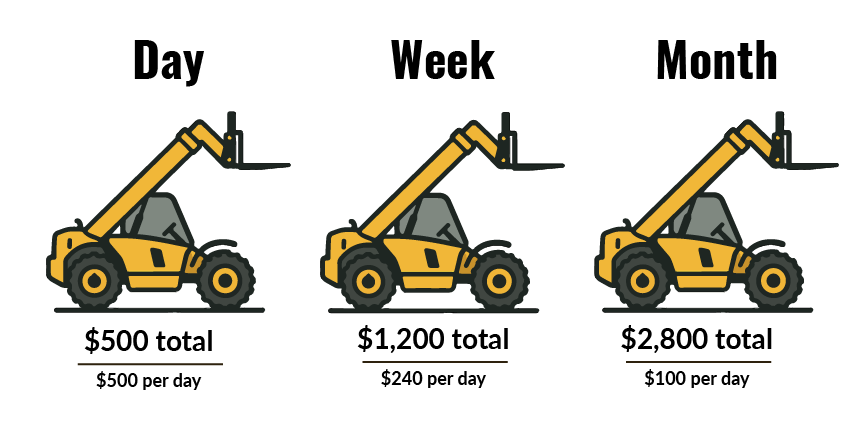
Hourly: Few providers offer true hourly rentals for telehandlers, but some have half-day or 4-hour rates. Expect roughly 50–60% of the daily rate for a half-day rental. If you only need a telehandler for a couple of hours (and the rental yard allows it), this can save money, but often a daily minimum charge applies.
Daily: Daily telehandler rentals generally start at a few hundred dollars for smaller units. A mid-sized model typically costs between $500 and $800 per day, depending on lift capacity and reach. The daily rate usually covers up to 8 hours of use in a single workday.
Weekly: Weekly rentals (5 to 7 days) usually provide a better value per day. A weekly rate is often about 3–4 times the daily rate. For example, if a telehandler is $500/day, the weekly might be around $1,500–$1,800 instead of $2,500 (which would be 5× the daily rate). In other words, renting by the week often effectively gives you a couple of free days compared to paying daily. Many rental companies include up to ~40 hours of use in one week.
Monthly: Monthly rentals (typically 4 weeks or 28 days) are the most cost-effective for long projects. A monthly rate is often equivalent to about 2–3 weekly rates. For example, a machine renting at $1,300 per week might be about $3,000 for a month. This steep discount means longer-term rentals significantly lower your cost per day. (Most monthly contracts assume about 160 hours of use over 4 weeks.)
Price Ranges Based on Size and Capacity
Not all telehandlers cost the same to rent – larger machines with higher lift capacities and reach come at a premium. Below are average 2025 rental price ranges by telehandler size (your rates may vary by region and provider):
| Telehandler Size & Specs | Daily Rate | Weekly Rate | Monthly Rate |
|---|---|---|---|
| Small 5,000 lb capacity, 19 ft reach (compact telehandler) | $478 – 647 | $1,143 – 1,543 | $2,458 – 3,514 |
| Medium 8,000 lb capacity, 42 ft reach (mid-size unit) | $578 – 780 | $1,429 – 1885 | $3,107 – 4,317 |
| Large 10,000+ lb capacity, 55+ ft reach (high reach unit) | $770 – 987 | $1,983 – 2,555 | $4,356 – 5,729 |
Note: These averages were compiled from telehandler rental listings across 10 major U.S. cities, including Milwaukee, Chicago, Minneapolis, Atlanta, Dallas–Fort Worth, Phoenix, Orlando, Los Angeles, Denver, and New York. Prices reflect base equipment rental only and do not include freight, fuel, damage waivers, or other potential fees.
We used a standard deviation method to calculate price ranges, providing a reliable benchmark. Your actual rental cost may vary based on your region, equipment availability, and rental provider.
Price Comparison – Renting vs. Buying

When does renting a telehandler make more financial sense than buying one? In short, renting is ideal for short-term or occasional needs, whereas buying requires a large capital outlay but makes sense if the equipment will be used constantly.
Purchasing a telehandler is a significant investment. A new telehandler can easily cost $70,000 to over $100,000 depending on its size. Even a used telehandler might cost $15,000 to $60,000 or more. For many businesses, it only makes sense to buy if the telehandler will be in use most days of the year.
Renting, on the other hand, lets you pay only for the time you need the machine. This avoids tying up capital and incurring maintenance, storage, and insurance costs year-round. Renting makes financial sense for seasonal projects, one-time jobs, or to temporarily replace a broken-down unit.
Key Factors That Affect Telehandler Rental Rates
Several key factors influence how much you’ll pay to rent a telehandler. Being aware of these can help you anticipate costs and even negotiate better rates:

Equipment Specs and Lift Height
The size, lifting capacity, and lift height of the telehandler are major pricing factors. Higher capacity and taller-reaching models command higher rental rates. Also, specialized features (like four-wheel steering, outriggers, or all-wheel drive which most have) add value.

Brand and Machine Age
The brand of the telehandler and the age/condition of the machine can affect pricing. Premium brands or newer models may have higher rental rates due to their reliability, advanced features, or lower hours. Rental companies sometimes offer older telehandlers at a slight discount, but older units might be less efficient or comfortable.

Attachments and Add-Ons
Think about what attachments you’ll need. Most telehandler rentals come with standard forks included in the base price. If you require special attachments – such as a truss boom, material bucket, or personnel work platform – these usually cost extra to rent. The add-on fee might be charged per day or week for each attachment.
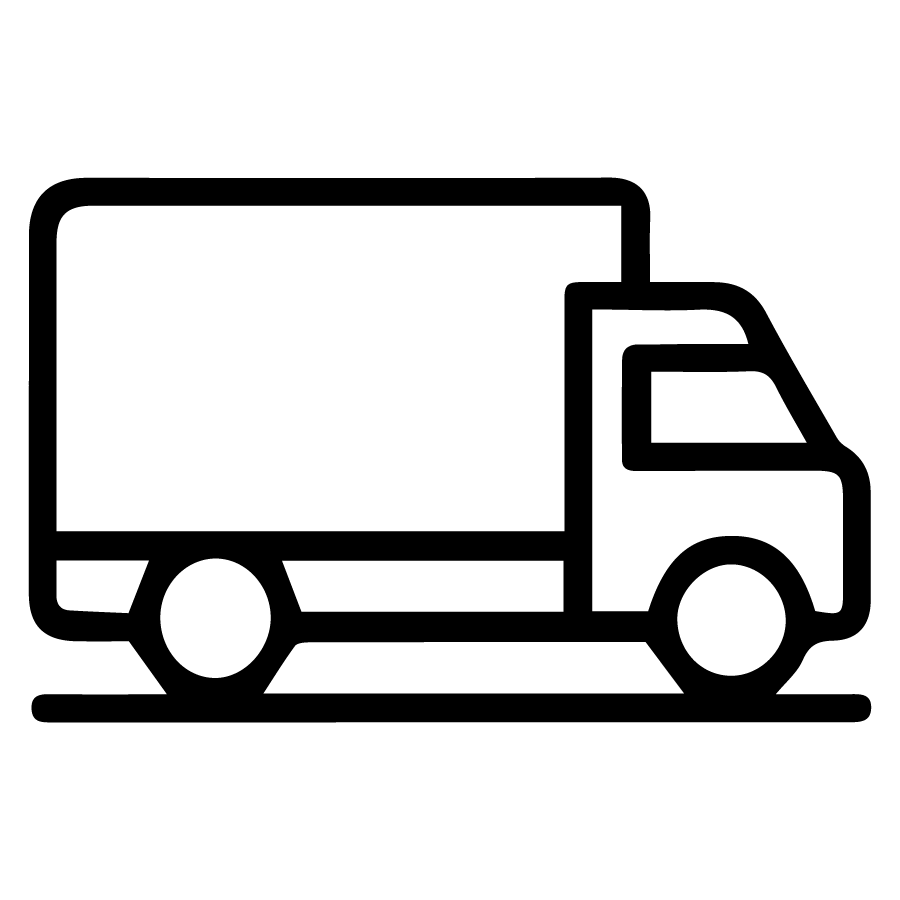
Delivery Fees and Fuel Charges
Don’t forget to account for transportation and fuel costs. Rental companies will charge a delivery/pickup fee to get the telehandler to your job site. To save on delivery, try to rent from a nearby provider or arrange to transport the machine yourself if you have the capability. Additionally, telehandlers are typically delivered full of fuel (diesel) and you’ll be expected to either return them full or pay a fuel surcharge

Rental Duration and Seasonal Demand
How long you rent will influence the rate – as noted, longer rental terms have lower average daily costs. But also consider seasonal demand. Telehandler rentals are in highest demand during peak construction seasons (often spring and summer). If you know you’ll need a telehandler in the busy season, try to book in advance to lock in a rate and ensure availability

Insurance and Damage Waivers
Lastly, factor in insurance and potential damage fees. Most rental companies require some form of insurance or damage waiver for the equipment. This can either be provided via your own business insurance (if it covers rented equipment) or purchased as a damage waiver from the rental company for an added fee.
Specialty Telehandler Rentals
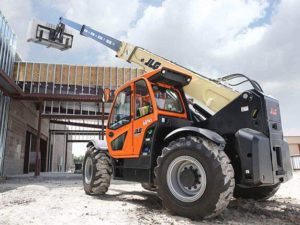
Telehandlers come in various types beyond the standard models, and you may encounter specialty telehandlers designed for particular applications. Knowing these can help you choose the right machine for the job or understand cost differences for specialized equipment:
Rough Terrain & All-Terrain Telehandlers
Nearly all construction-grade telehandlers are rough terrain telehandlers, built to perform on unpaved, uneven surfaces. These machines feature four-wheel drive, high ground clearance, and often stabilizing outriggers. If you see a telehandler advertised as “all-terrain,” it typically means it has robust off-road capability and possibly foam-filled or heavy-tread tires to prevent flats on construction debris.
Rotating Telehandlers (Roto Models)
Rotating telehandlers (often called “Roto” telehandlers) are a special breed of telehandler that can spin the upper frame 360 degrees like a crane. This gives them incredible versatility on tight job sites – you can park the machine in one spot and rotate the boom around to cover a wide area, rather than repositioning the whole vehicle. Roto telehandlers often come with outriggers for extra stability and can double as mobile cranes or even aerial work platforms with the right attachment.
High-Reach & Heavy-Lift Units
Some telehandlers are built specifically for extreme reach or heavy lifting beyond typical models. “High-reach” telehandlers can extend 55–70 feet up, useful for tasks like erecting tall structures or servicing multi-story buildings. Heavy-lift telehandlers have very high lifting capacities (12,000+ lbs), useful in industrial applications like moving shipping containers or large pipe sections.
Telescopic Forklifts vs. Traditional Lifts
You might hear telehandlers referred to as “telescopic forklifts.” They indeed perform many forklift tasks but with the added benefit of reach. It’s important to know when a telehandler is the right choice versus a standard vertical-mast forklift or other lift. A traditional forklift is ideal for quick loading and unloading on smooth surfaces, especially indoors in warehouses.
Tips to Get the Best Telehandler Rental Rates

Every project manager or business owner wants to save on rental costs. Here are some tips to ensure you get the best rate and value for your telehandler rental:
Book Ahead During Peak Seasons
As mentioned, demand drives pricing. To avoid paying surge prices or scrambling for an available machine, reserve your telehandler well in advance if your project is during the busy season. Booking a month or more ahead can sometimes lock in off-peak rates before they potentially rise.
Bundle Rentals with Other Equipment
Do you also need a scissor lift, forklift, or other equipment alongside your telehandler? Bundling your rentals with one provider can often yield a discount or at least save on delivery fees. Rental companies appreciate larger contracts, so they might offer, say, 5–10% off if you rent multiple pieces of equipment at once.
Understand the Rental Agreement
It’s crucial to read and understand your rental contract so you’re not caught off-guard by extra charges. Pay attention to included usage hours and overtime policies: most contracts define a “day” rental as up to ~8 working hours, a week as 5 x 8-hour days (40 hours), and a month as 4 x 40 (160 hours).
Frequently Asked Questions
How much does it cost to rent a telehandler for a month?
Monthly telehandler rental rates generally range from around $1,500 at the low end up to $3,000 or more for the largest models. The exact cost depends on the telehandler’s capacity, reach, and your region. Always get a quote for the specific model you need, as monthly rates often include discounts compared to shorter terms (making them cost-effective if you have a long project).
Are attachments included in the rental rate?
Typically, standard forks are included with a telehandler rental at no extra charge. If you need specialized attachments beyond the forks, those usually are not included in the base rate. Attachments like buckets, jib cranes, rotators, or work platforms will incur an additional rental fee (often charged per day or week) on top of the telehandler itself.
What’s the cheapest telehandler to rent?
The cheapest telehandler to rent will be the smallest, most basic model available. Usually, that’s a compact telehandler with around 5,000 pounds lift capacity and a 19-ft boom. These units are lighter, easier to transport, and cost less to own and maintain – so rental rates are lower.
How can I save on delivery or fuel surcharges?
To save on delivery fees, try to rent from the closest possible equipment provider to your job site. The shorter the distance the telehandler has to travel, the lower the delivery (and pickup) charge is likely to be.
Conclusion
Telehandler rental costs can vary widely depending on machine size, rental duration, location, and seasonal demand. While a compact telehandler may rent for under $500 a day, larger high-reach or heavy-lift models can command significantly higher rates. By understanding the different pricing tiers and the factors that influence rental rates—such as equipment specs, attachments, transportation fees, and more—you can better budget for your project and avoid unexpected expenses.
If you’re planning a job that requires heavy lifting, extended reach, or rough terrain capabilities, renting a telehandler can deliver the performance you need without the financial commitment of ownership. To get the best deal, plan ahead, compare providers, and ask about bundled pricing or long-term discounts. With the right preparation, you’ll get maximum value from your telehandler rental—and keep your project running smoothly and efficiently.
